Management
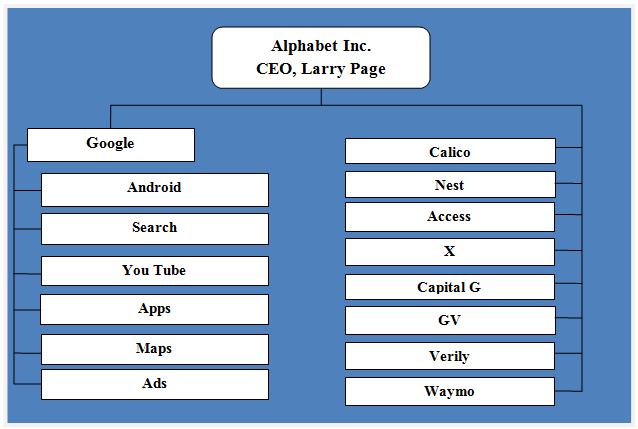
Alphabet Inc. organizational structure is divisional. Each division is positioned as a separate brand such as Google, Calico, Nest, Access (Fiber) and others. Alphabet’s individual divisions have flat organizational structure and this gives business a range of benefits such as lack of bureaucracy, high level of flexibility and effective two-way communication between senior management and other employees. Google Inc. was restructured in 2015 to become Alphabet Inc. “Google’s search product became a wholly owned subsidiary of a new parent company, Alphabet, with other Google projects and teams spun out into separate “Alphabet companies,” each with its own CEO.”[1]. Alphabet Inc. is a holding company with no business operations of its own. The main aim behind this restructuring was to help entrepreneurs build and run companies with the autonomy and speed they need. In other words, the company was restructured to move beyond search engine business and to engage in diversification strategy to a greater extent. Introduction of new businesses such as Waymo, a self-driving car company and Debug project, which aims to stop mosquitoes in their tracks have been enabled by this restructuring initiative. Figure below illustrates Alphabet Inc. organizational structure: Alphabet Inc. organizational structure The current pattern of Alphabet Inc. organizational structure gives CEO Larry page and the senior leadership greater freedom to explore new projects and acquisitions — regardless of how they fit into Google’s mission “to organize the world’s information and make it universally accessible and useful.” Alphabet Inc. (Google) Report contains a full analysis of Alphabet Inc. organizational structure. The report illustrates the application of the major analytical strategic frameworks in business studies such as SWOT, PESTEL, Porter’s Five Forces, Value Chain analysis and McKinsey 7S Model on Alphabet Inc. Moreover, the report contains analyses of Alphabet leadership, business strategy and organizational culture. The report also…
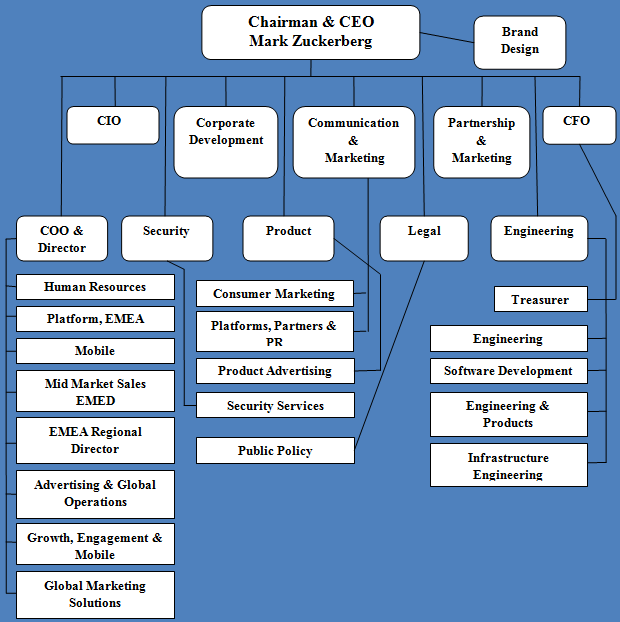
Facebook Inc. organizational structure can be described as hybrid and combines certain elements of hierarchical and divisional organizational structures. On one hand, with more than 12600 employees worldwide, Facebook Inc. maintains a hierarchical organizational structure integrating multiple levels of commands from CEO Mark Zuckerberg to ordinary programmers and designers. On the other hand, there are product-based divisions and global teams that focus specific products such as Facebook, Instagram, Messenger, WhatsApp and Oculus. Product-based teams also engage in the development and improvement of a wide range of services offered by the company. For example, services such as Profile, Newsfeed, Messenger, Groups and Events offered within Facebook social networking site is the result of work done by product-based divisions. Figure 1 below illustrates Facebook Inc. organizational structure In 2016 it has been found that the company was planning “to restructure its shares to give Mark Zuckerberg ultimate control even as the social network’s founder plans to sell most of his stake in the company”[1]. Earlier that year, Mark Zuckerberg had announced his pledge to donate 99 per cent of his fortune to charitable efforts including combating various diseases and climate change via selling his Facebook stocks. Accordingly, the new share structure to be introduced by Facebook Inc. is intended to ensure that Mr. Zuckerberg retains his 60 per cent voting power even after he departs with 99 per cent of his Facebook shares. A similar initiative had been introduced in Facebook’s main rival company, Google, where founders Larry Page and Sergey Brin were able to retain control of the company through introducing stock restructuring… Facebook Inc. Report comprises a comprehensive analysis of Facebook. The report illustrates the application of the major analytical strategic frameworks in business studies such as SWOT, PESTEL, Porter’s Five Forces, Value Chain analysis and McKinsey 7S Model on Facebook…
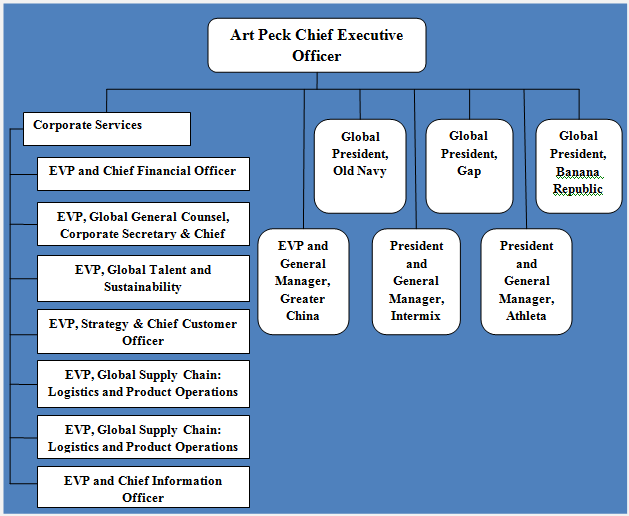
Gap Inc. organizational structure can be characterized as hybrid integrating certain elements of divisional and hierarchical organizational structures. Gap organizational structure has the following pattern: Gap Inc. organizational structure As it is illustrated in figure above, Gap organizational structure is divided into five divisions with each division representing a separate brand and headed by a president. At the same time, the organizational structure of each division is highly hierarchical and there are multiple levels of management between the president of the division and a shop floor assistant. In 2016, as a part of an initiative to address declining sales and profitability, Gap CEO Art Peck announced plans for global restructuring that includes reducing the numbers of Gap stores in the US, withdrawing the Old Navy fascia in Japan and making head office redundancies.[1] Moreover, store closures also involved Banana Republic brand bringing the total expected store closure count to 75 by the end of fiscal 2016.[2] There are also occasional brand-specific changes in organizational structures led by the presidents of respective brands. For example, a major restructuring introduced in Gap brand in 2015 included combining e-commerce and marketing organization into one unit and elimination of Creative Director role resulting in Rebekka Bay’s departure from the company.[3] Organizational structure of Gap Inc. may be subjected to further changes to a considerable extent in the foreseeable future to address serious challenges the company is facing. Specifically, net sales for fiscal 2015 decreased 4 percent to USD 15.8 billion compared with USD 16.4 billion for fiscal 2014. Gross profit for fiscal 2015 was USD 5.7 billion compared with USD 6.3 billion for fiscal 2014.[4] Accordingly, we can expect the company to engage in downsizing of management layers along with further store closures in developed countries to concentrate more in strategic developing countries such as China,…
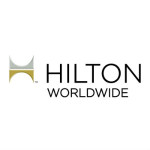
Hilton organizational structure is hierarchical due to the massive size of the business that comprises 13 brands serving 140 million guests in 2015 alone. Moreover, Hilton organizational structure can also be described as divisional and the business is divided into the following divisions[1]: Ownership division comprises 146 hotels with 59,463 rooms which are owned or leased by Hilton Worldwide Management and franchise division comprises 4,419 hotels with 691,887 rooms. Timeshare division comprises 45 properties and 7,152 units. Since his take over as Hilton Worldwide President and CEO in 2007, Christopher J. Nassetta introduced restructuring and other initiatives in the following directions: Gradual restructuring of senior level management, as a result of which only about 30 per cent of top 100 the most senior management remained in their jobs by June 2014[2] Increasing communication and cooperation with individual business units and Hilton Worldwide head office partially via improving organizational culture27 Enhancing organizational culture to promote the spirit of unity and increasing the speed of decision making at all levels Increasing the level of integration of timeshare unit with Hilton Worldwide resulting in 44 per cent increase in timeshare unit revenues during the following six years Moving the head office from Beverly Hills, California to McLean, Virginia taking only about 100 out of 500 employees from the headquarters Hilton Worldwide Holdings Inc. Report comprises a comprehensive analysis of Hilton business strategy. The report illustrates the application of the major analytical strategic frameworks in business studies such as SWOT, PESTEL, Porter’s Five Forces, Value Chain analysis and McKinsey 7S Model on Hilton. Moreover, the report contains analyses of Hilton’s marketing strategy and discusses the issues of corporate social responsibility. [1]Annual Report (2015) Hilton Worldwide [2]Heath, T. (2014) “Christopher Nassetta: The man who turned around Hilton” The Washington Post, Available at: https://www.washingtonpost.com/business/capitalbusiness/christopher-nassetta-the-man-who-turned-around-hilton/2014/07/03/43071478-fd5a-11e3-932c-0a55b81f48ce_story.html
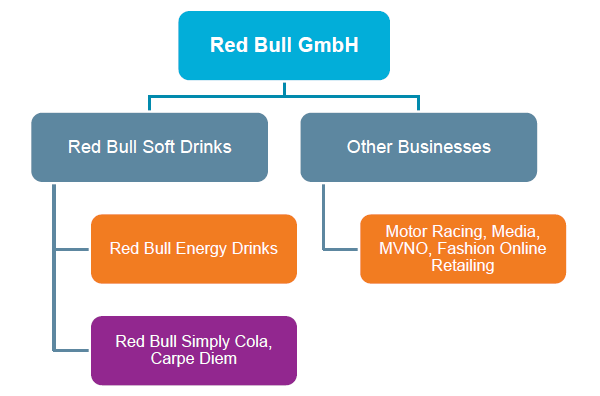
Red Bull organizational structure is divisional and the business is divided into two large businesses – Red Bull soft drinks and other businesses. It can be mentioned that divisional organizational structure “groups together those employees who are responsible for a particular product type or market service according to workflow”[1] As it is illustrated in Figure 1 below, other businesses division comprise motor racing, media, MVNO and fashion online retailing, whereas Red Bull soft drinks division is further divided into two sub-divisions: Red Bull energy drinks and Red Bull Simply Cola and Carpe Diem. Figure 1 Red Bull organizational structure The choice of divisional organizational structure by Red Bull provides the business with a set of advantages that include achieving a great focus upon a single product or service. Additionally, divisional structure allows building “a common culture and esprit de corps that contributes both to higher morale and a better knowledge of the division’s portfolio”[2]. Red Bull founder and CEO Dietrich Mateschitz subjects Red Bull organizational structure to certain changes in a systematic manner in order to reflect changes in the external environment. It is important to clarify that Red Bull organizational structure is not a typical divisional structure in a way that it also integrates certain elements of hierarchical structure in specific programs. For example, as it is illustrated in Figure 2 below, Red Bull wings program that involves distribution of free samples of products contains 6 layers of management from the team member to the program leader. Figure 2 Red Bull Wings program structure Red Bull GmbH Report comprises a comprehensive analysis of Red Bull. The report illustrates the application of the major analytical strategic frameworks in business studies such as SWOT, PESTEL, Porter’s Five Forces, Value Chain analysis and McKinsey 7S Model on Red Bull. Moreover, the report contains analyses of Red Bull’s marketing strategy and discusses…
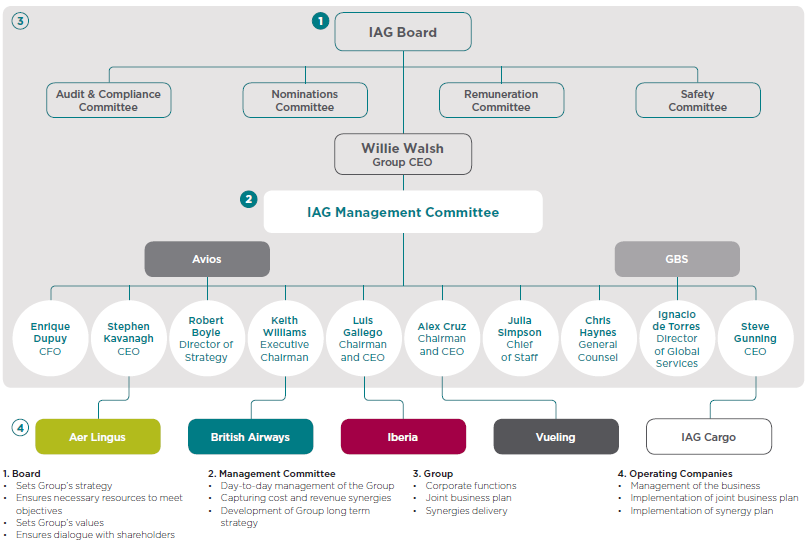
Organizational structure of a business determines the manners of which the primary objective of profit maximization is achieved. More specifically, organizational structure is the reflection of roles and tasks of employees and the scope of their contribution to the achievement of organizational objectives. British Airways is a part of International Airline Group (IAG). Along with British Airways, AIG also owns Iberia, Vueling and Aer Lingus and the airline group has the following structure: Figure 1 IAG management structure British Airways organizational structure was subjected to certain changes early in 2015. The company announced it would split its marketing team with part of the team joining the commercial department and the other forming a new customer experience team, which focuses solely on the travel experience.[1] Such a pattern of restructuring is a clear attempt to place marketing at the forefront of airline’s business strategy. The latest pattern of British Airways organizational structure before Alex Cruz took over as the new CEO from Keith Williams in April 2016 as illustrated in Figure 2 below: Figure 2 British Airways organizational structure It can be argued that British Airways organizational structure may be subjected to certain changes in the foreseeable future to reflect strategic changes to be introduced by the new CEO Alex Cruz. Specifically, “the consensus at IAG is that Cruz has done a good job at Barcelona-based Vueling, fending off budget rivals like Ryanair and EasyJet on routes around Europe”[2] and this is one of the reasons he has been appointed to lead British Airways. Accordingly, one can expect Alex Cruz will cost-cutting measures that may involve de-layering of British Airways organizational structure. British Airways Report comprises a comprehensive analysis of British Airways. The report illustrates the application of the major analytical strategic frameworks in business studies such as SWOT, PESTEL, Porter’s…
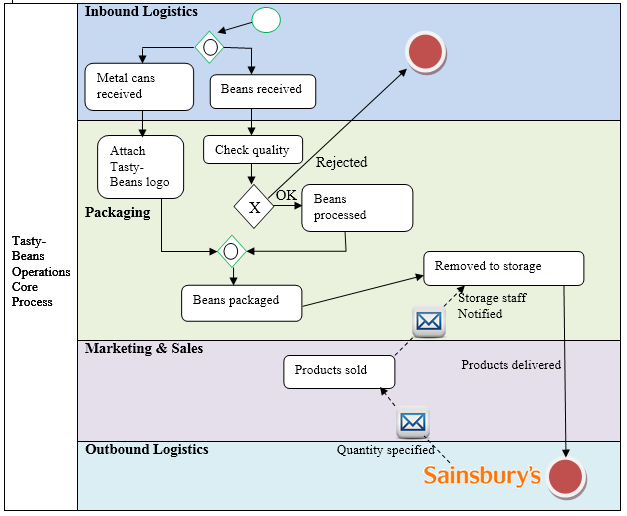
Introduction This article explains core process mapping that directly contribute to the production of Tasty-Beans brand of canned beans owned by Tasty-Beans Co. by to be delivered to Sainsbury’s Plc distribution centres, one of the largest supermarket chains in UK. Moreover, the paper contains in-depth illustration of lower-level mapping that focuses on packaging element of core business processes. Core business processes of Tasty-Beans Co. in general, and packaging element are explained in this paper with the application of ‘Four V’s’ and IGOE frameworks. Tasty-Beans Operations Core Process Mapping Business process can be defined as “well-understood interplay of activities that targets a certain business objective” (Draheim, 2010, p.75). Accordingly, for the case of Tasty-Beans, business process relates to the process of manufacturing and selling canned beans for the purposes of profit maximisation. Business processes can be divided into two categories: core and support. Core processes related to the production of products and services in direct manner, and they include operations, inbound and outbound logistics, and marketing and sales (Burlton, 2001). Support processes, on the other hand, “do not add value, but are necessary to assure that the core processes continue to function” (Harmon, 2007, p.86), and support processes include human resources development, development of technology, procurement and overall infrastructure. BPNM stands for Business Processes Modelling Notation and it assists with finding and utilising possibilities for increasing the levels of effectiveness of various business processes. Mapping of Tasty-Beans Co. canned been manufacturing operations provided below only comprise core processes: Analysis of Sub-Section Process: Packaging Illustration of Mapping of Tasty-Beans Co. canned been manufacturing operations provided above captures main activities within core elements of operations in general manner. Each of lanes within the pool such as inbound logistics, packaging, marketing and sales and outbound logistics can be further expanded in a lower level map in order to…
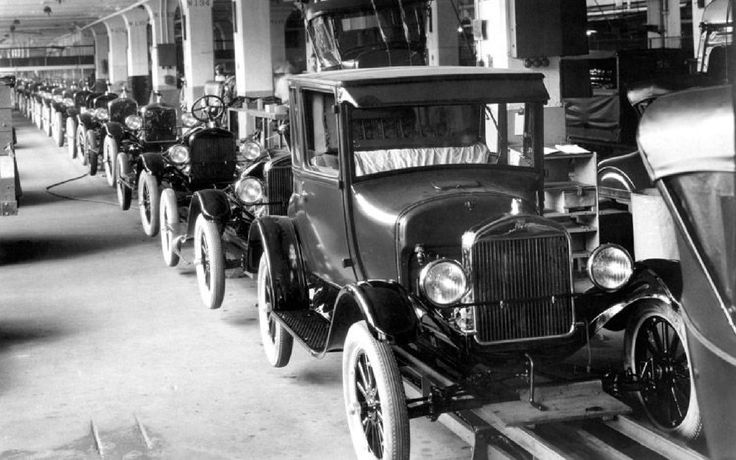
1. Introduction Fordism can be defined as “a set of principles that includes technological measures, especially mass production on the assembly line, as well as economic strategies such as supporting mass consumption by lowering prices and increasing wages”[1]. The term is coined by Antonio Gramsci after the name of Henri Ford, a famous US industrialist and the founder of Ford Motor Company. The concept of Fordism has developed starting from 1910’s to reach its peak in the period between 1940’s to 1960’s. Fordism is closely associated with the notions of mass production and consumption. Prior to mass production assembly lines introduced initially in Ford factories, products were manufactured with the method of craft production, which involved the same workers being engaged in the many stages of manufacturing processes. The consumption point of Fordism stems from Henri Ford’s belief that company employees need to be able to purchase cars produced by Ford, thus the level of their wages were increased. Thus, it can be reasoned that “Model T, sold in millions, can be viewed as the herald of consumerism, the new phase in human history when consumption came to be seen no just as the means of survival but as the true path to the good and happy life”[2]. This article represents a critical evaluation of the concept of ‘Fordism’ within the settings of international political economy a range of related issues. The article starts with discussions about the evolution of Fordism. This is followed by critical assessment of the concept within modern international political economy. Moreover, the article contains a reflection of criticism associated with Fordism and analysis of circumstances that enabled emergence of Neo-Fordism. 2. Evolution of Fordism It has been argued that Fordist method of mass production primarily owes to the teachings of Taylorism, which has created…

Tesco Board of Directors comprises 10 members and there were significant changes in the Board during the financial year 2014/15. These changes include the appointment of John Allan as the Chairman of the Board, the appointment of a new CEO Dave Lewis and new Chief Financial Officer Alan Steward, the retirement of four Non-Executive Directors and the appointment of three new Non-Executive Directors. In 2015, Mr. Lewis announced the reduction of costs across head office functions by 30 per cent with direct implications on the management structure. As it is illustrated in Figure 1 below, Tesco governance structure comprises five committees reporting to Tesco PLC board. There are 11 members in Tesco Executive Committee led by Group Chief Executive Dave Lewis. Figure 1 Tesco Corporate Governance Structure Tesco organizational structure is highly hierarchical reflecting the large size of the business. Even in store level, there are as many as four layers of management in some large stores. The Figure 2 below illustrates a typical organizational structure within Metro, Superstore and Extra formats. It is important to note that the structure below is not rigid for all Tesco stores and some stores operate with a slightly different structure reflecting their location, size and a range of other store-specific factors. Figure 2 Tesco organizational structure at store level It can be argued that three or four management layers within a single store may create unnecessary bureaucracy with a negative implications on the flow of information across the management layers. Therefore, the senior level management needs to consider delayering opportunities i.e. increasing the flexibility of operations and changes within store and accelerating the flow of information via reducing the layers of management. Tesco PLC Report comprises a comprehensive analysis of Tesco. The report illustrates the application of the major analytical strategic frameworks in…
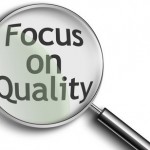
It has been stated that Total Quality Management (TQM) “is difficult to define precisely because it is a philosophy of total organisational involvement in improving all aspects of quality” (Allen, 2004, p.68), nevertheless, in a broad manner TQM can be defined as a quality improvement philosophy that adopts a holistic approach and requires active participation of all employees. Initially developed by Edward Deming in 1940s, TQM became a buzzword in the US several decades later due to its implementation by a range of large companies such as Ford Motor Company, Motorola, and Xerox. University and colleges, as well as, many other organisations in all industries can apply TQM elements in practice in order to increase the level of customer satisfactions significantly. TQM elements include understanding customer needs, doing things right the first time, continuous improvement, regular assessments of quality related costs, developing effective systems and procedures etc. ‘Getting things right the first time’ is one of the fundamental TQM elements. This approach substitutes quality inspection practices with constant search and utilisation the potentials for quality improvement. The approach of ‘getting things right the first time’ can benefit the college in terms of avoiding waste of resources, and saving substantial amounts of time and money. TQM principle of continuous improvement is associated with Kaizen philosophy and its applicability is extended beyond organisational environment to cover personal life, relationships, social life etc. Main advantages of Kaizen principles for the college The value of continuous improvement or Kaizen for the college is even grater taking into account the fact that implementation of this principle does not require vast financial investments on behalf of the college and improvements can be introduced in a gradual manner. Another vital TQM element can be identified as understanding customer needs in the first place so that relevant products…
